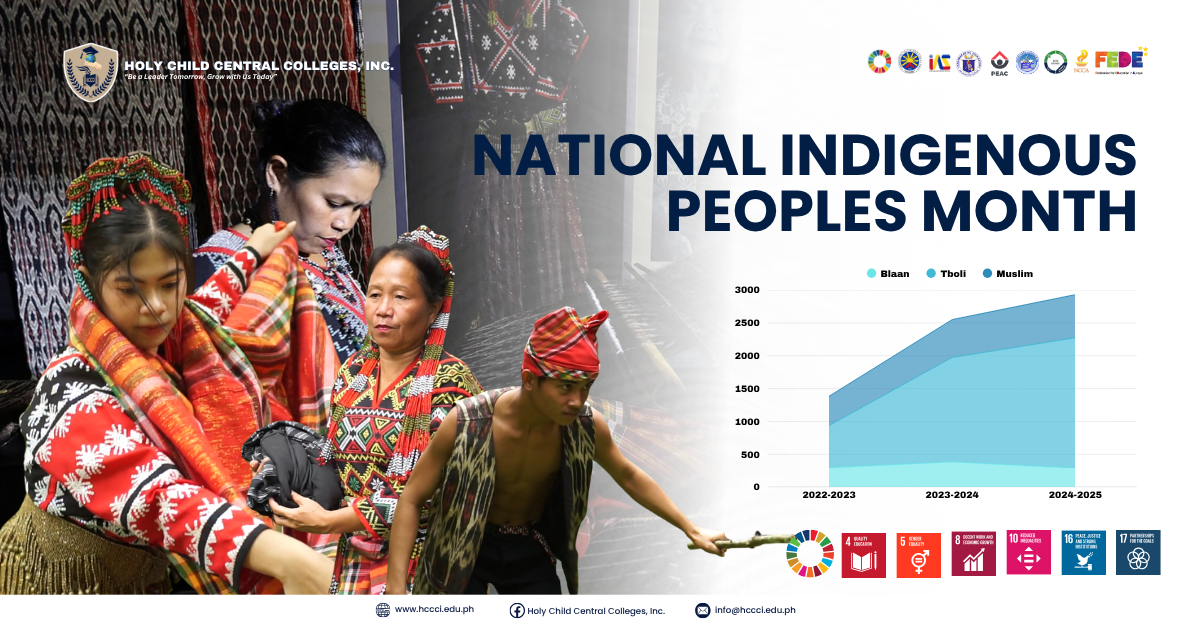𝐆𝐫𝐨𝐰𝐭𝐡, 𝐄𝐦𝐩𝐨𝐰𝐞𝐫𝐦𝐞𝐧𝐭, 𝐚𝐧𝐝 𝐈𝐧𝐜𝐥𝐮𝐬𝐢𝐯𝐢𝐭𝐲: 𝐇𝐂𝐂𝐂𝐈 𝐒𝐭𝐫𝐞𝐧𝐠𝐭𝐡𝐞𝐧𝐬 𝐂𝐨𝐦𝐦𝐢𝐭𝐦𝐞𝐧𝐭 𝐓𝐨𝐰𝐚𝐫𝐝𝐬 𝐈𝐧𝐝𝐢𝐠𝐞𝐧𝐨𝐮𝐬 𝐏𝐞𝐨𝐩𝐥𝐞𝐬
Every October, Holy Child Central Colleges, Inc. (HCCCI) proudly joins the nation in celebrating Indigenous Peoples (IP) Month, reaffirming its mission of inclusivity, empowerment, and accessible education for marginalized communities. As an institution where nearly 80% of the student population come from Indigenous Peoples (IP) groups, HCCCI stands as a home for diverse cultures, ensuring that education becomes both a right and a bridge toward opportunity.
HCCCI has witnessed remarkable growth in its student population, highlighting the increasing presence of Indigenous Peoples (IPs), especially in Higher Education. Data show that from 1,081 students in SY 2020–2021, the population of HCCCI has continually increased to 3,659 students in SY 2025–2026, with enrollees coming from the Tboli, Blaan, and Muslim communities, as well as from the cultural groups of Ilonggo, Cebuano, and Tagalog.
Based on recorded data, the Tboli tribe had the largest number of enrollees, growing from 386 students in SY 2020–2021 to its peak in SY 2024–2025 with 1,986 students, and continuing with 896 students in SY 2025–2026. The Blaan community also displayed growth, increasing from 85 enrollees in SY 2020–2021 to 484 in SY 2025–2026. The Muslim population likewise showed a significant increase, from 47 students in SY 2020–2021 to 262 in SY 2025–2026, with SY 2024–2025 marking its peak year at 656 enrollees.
These figures demonstrate not only the growing trust of Indigenous communities in HCCCI but also their recognition of education as a powerful tool to uplift families through quality and accessible learning, while also preserving cultural identity. By equipping learners with both academic excellence and leadership grounded in cultural heritage, HCCCI’s Center for Internationalization and Indigenous People (CIIP) continues to shape students into globally competitive professionals who carry their roots with pride.
HCCCI’s achievements align with the United Nations Sustainable Development Goals, showing measurable impact across multiple indicators. By ensuring access for nearly 3,700 students from Indigenous and marginalized groups, the institution advances SDG 4: Quality Education, particularly its indicator on ensuring equal access to affordable higher education. Through the skills and opportunities provided to students, HCCCI contributes to SDG 8: Decent Work and Economic Growth, especially in reducing the number of youths not in education, employment, or training. In embracing Indigenous learners without discrimination, the institution supports SDG 10: Reduced Inequalities, which emphasizes social, economic, and political inclusion. The harmony cultivated among its diverse learners reflects SDG 16: Peace, Justice, and Strong Institutions, particularly in fostering participatory and inclusive decision-making. Finally, through strong local and international partnerships that sustain programs for Indigenous Peoples, HCCCI advances SDG 17: Partnerships for the Goals, which focuses on strengthening multi-stakeholder collaborations.
The rising number of Indigenous student enrollments underscores the importance of education as a tool for empowerment, grounded in the institution’s commitment to breaking barriers for marginalized sectors. This commitment has defined HCCCI’s pathway as the Center for Internationalization and Indigenous People (CIIP), equipping IP learners not only academically but also as leaders and professionals who carry their culture with pride in both national and international endeavors.
More than an educational institution, HCCCI has become a movement for equity, empowerment, and resilience. Its story is not only about numbers or infrastructure but about communities whose children now have the chance to dream bigger. By investing in technology, including building cell sites and creating its own Learning Management System to reach geographically challenged areas, HCCCI has ensured that no learner is left behind. The institution continues to shape Indigenous Peoples into professionals, leaders, and cultural bearers who will carry their identities proudly on national and global platforms.
As HCCCI celebrates Indigenous Peoples Month, it also celebrates the future it is helping build—a future where Indigenous voices are not only included but empowered, where education reaches even the most distant communities, and where every student stands as living proof that access, equity, and opportunity can change the course of generations.
